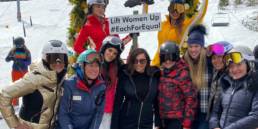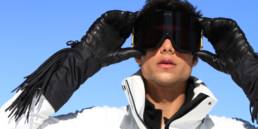Dave McCoy – A Mammoth of a Man
DAVE MCCOY, FOUNDER OF MAMMOTH MOUNTAIN, TURNS 100
“We always laughed that Dave led by pulling on the rope, he wasn’t behind cracking the whip, pushing the rope.” — Long-time Mammoth ski coach and employee Dennis Agee
Standing at the top of Dave’s Run, it’s easy to see what attracted Dave McCoy to Mammoth Mountain. The sculpted cornices and brilliant white bowls that go on forever beckon those with skiing in their blood. And that pretty much defines Dave McCoy.
 McCoy turned 100 last August. Over 68 years at the helm of Mammoth Mountain, he grew the ski area on this snow-covered lava dome from a couple of portable rope tows to the monumental resort that it is today — with 28 lifts, including three gondolas, and 3,500 acres of skiing. Why? Because McCoy wanted to have fun. And he wanted those around him, whether they were building new chairlifts, racing gates, or skiing through several feet of untracked powder, to have fun too.
McCoy turned 100 last August. Over 68 years at the helm of Mammoth Mountain, he grew the ski area on this snow-covered lava dome from a couple of portable rope tows to the monumental resort that it is today — with 28 lifts, including three gondolas, and 3,500 acres of skiing. Why? Because McCoy wanted to have fun. And he wanted those around him, whether they were building new chairlifts, racing gates, or skiing through several feet of untracked powder, to have fun too.
With a personality — and a following — perhaps larger than Mammoth, Dave McCoy and Roma, his wife of 74 years, are quick to share the praise. “The family and the community were always a big part of our success, as they helped play in the big sandbox as well,” McCoy wrote on his website DaveMcCoyPhoto.com. “It shows that no man does anything alone.”
Mammoth’s community of friends, employees, townspeople, ski racers, and many others, stuck with McCoy for a reason.
Born on August 24, 1915 in El Segundo, California — just south of what’s now LAX International Airport — Dave McCoy was only 5 years old when his father quit his job at the Standard Oil Refinery and began working as a state highway contractor. With thousands of miles of California roads to pave, the McCoys lived an itinerant life, traveling from one tent encampment to the next. An only child, McCoy quickly learned how to make friends, and perhaps more importantly, how to “look at a guy and know what he’s like,” McCoy once told Sports Illustrated.
In 1928, McCoy visited Independence, a town along U.S. Route 395 in the Owens Valley. With the snowcapped Eastern Sierra rising from Independence like a theater backdrop, he was
captivated. The nomadic boy had found the place where he would spend his life.
“I couldn’t get over the snow on the mountains in the middle of July,” he told Robin Morning in the McCoy biography, Tracks of Passion. “This spiritual feeling came over me, a sense
of opportunity, and desire. I felt like I belonged, and I knew I would come back.”
He did come back, in 1935 — after a few years living with his grandparents in Wilkeson, Washington, where he learned to ski. In Independence he worked at Jim’s Place, a restaurant owned by his mom’s friends, then became a hydrographer for the L.A. Department of Water and Power. His job: to ski into the backcountry, measure snow depth, and estimate how much water would flow downstream each spring. Before he left Jim’s Place, he met a curly-haired cheerleader named Roma Carriere — they married in 1941.
 Skiing was more than a means to work. It was pure fun — swooping through snowfields was the definition of freedom. McCoy built portable rope tows so he and his friends could ski on
Skiing was more than a means to work. It was pure fun — swooping through snowfields was the definition of freedom. McCoy built portable rope tows so he and his friends could ski on
the weekends. Friends and ski lovers flocked to McGee Mountain (about 16 miles southeast of Mammoth Mountain along Route 395) to ride McCoy’s tows. When the snow melted in the valleys, he moved his tows higher, first skiing Mammoth’s slopes on Easter Sunday 1936. The cost of a lift ticket: A smile. As grandson David Barrett says, “He manufactured fun.”
But Dave and Roma still had to eat. One weekend shortly after they were married, they ran out of money. With a few days until McCoy received his next paycheck, he suggested to Roma that she charge 50 cents to ride the rope tow. Roma was mortified… until she realized that they collected $15, and people still smiled.
A talented ski racer — even after he shattered his leg racing in the California State Championship in 1942 — McCoy was also a renowned coach. He coached local legends like Jill Kinmont, Linda Meyers, and his daughter Penny, who won a bronze medal in slalom at the 1966 World Championships. And some of the nation’s top skiers — Jean Saubert and Joan Hannah, to name just two — came to Mammoth to ski with McCoy.
“None of those people were invited, they came to ski,” says Dennis Agee, who was inspired by McCoy to learn to ski after his family moved to Mammoth. “It was almost like a skiing field of dreams.”
 McCoy coached each person differently and made instruction clear by explaining the physics of the sport. “He had the ability to see what each individual’s challenges were, and he spoke to those challenges,” adds Agee. “He didn’t say, ‘This guy is the best skier in the world, you have to look like him.’ He looked at you as an individual and brought out your strengths and recognized your weaknesses and came up with a program for each of us that allowed us to fulfill what God-given talents we had.”
McCoy coached each person differently and made instruction clear by explaining the physics of the sport. “He had the ability to see what each individual’s challenges were, and he spoke to those challenges,” adds Agee. “He didn’t say, ‘This guy is the best skier in the world, you have to look like him.’ He looked at you as an individual and brought out your strengths and recognized your weaknesses and came up with a program for each of us that allowed us to fulfill what God-given talents we had.”
And he focused on every skier, not just the stars. “He was always positive to all of us who were less than athletic but willing to work,” says Dennis “Poncho” McCoy, Dave and Roma’s second-oldest son. “He always made it fun for us.”
McCoy also made it fun to work for him; his passion for building a ski area was as great as his desire to play on it. When no one else thought that Mammoth Mountain was a good location for a ski area — too windy, too snowy, too high, too avalanche-prone, and too isolated — McCoy thought otherwise. He had had too much fun skiing its glades. So when the U.S. Forest Service asked how he would develop the mountain, he drew three lines on a piece of paper showing where he would put the lifts. The Forest Service gave McCoy a permit.
Two weeks before his sixth child was born in November 1953, McCoy requested a leave of absence from the LADWP and began welcoming skiers to his rope tows at Mammoth Mountain. Over the next couple of decades, Mammoth became truly mammoth, paralleling the growth of California in the boom that followed World War II. Unlike other ski area founders, he did it without investors, taking out small loans and pumping any profit back into the mountain. But mostly, Mammoth’s growth was fueled by passion, hard work, and ingenuity.
“He’s one of these guys, because he is so passionate, he has a sparkle in his eye and a grin on his face almost all the time,” says Poncho, “really, all the time.”
And he wanted to put a smile on the faces of those who came to Mammoth. Barrett remembers driving to the mountain with his grandfather and asking why he didn’t want to make Mammoth a high-end destination resort like Aspen or Vail. “He said, ‘I don’t want to beat Vail or Aspen,’” recalls Barrett, now a TV producer in New York City. “He said, ‘I am in this business to manufacture fun. If I can make it as cheap as possible so that I can see as many families as I can possibly see smiling down that mountain, that is what drives every decision
that I make.’”
 Mammoth’s growth was also fueled by the hard work of others who came to work at the mountain. Like the young ski racers who trained at Mammoth, these employees were drawn to work for McCoy. He never asked them to come. He was, as Dennis Agee says, the pied piper.
Mammoth’s growth was also fueled by the hard work of others who came to work at the mountain. Like the young ski racers who trained at Mammoth, these employees were drawn to work for McCoy. He never asked them to come. He was, as Dennis Agee says, the pied piper.
“His management style was by example,” says Agee, who worked at Mammoth before and after stints coaching the U.S. Ski Team. “He never asked anybody at the mountain to do anything that he hadn’t done, whether it be driving a snowcat, a cement truck, or a loader to clear trails. We always laughed that Dave led by pulling on the rope, he wasn’t behind
cracking the whip, pushing the rope.”
McCoy also empowered people. Clifford Mann, who grew up racing at Mammoth and ran mountain operations, remembers the summer when he turned 12. McCoy let his youngest son, Randy, and young Clifford drive a bulldozer to fill around the foundation of the mid-mountain lodge. Three years later, Clifford helped build Chair 6. He was 15 years old.
“Some kids got Tonka toys,” says Mann. “We got the real deal.” They worked through good times and bad, surviving snow droughts and years where there was so much snow that it buried the ski area. They survived avalanches, earthquakes, and volcanic activity, and recessions and gas shortages. Through it all, McCoy was positive. “We’re going to get it done,” Mann remembers McCoy saying in 1990 when he tasked Mann with developing a snowmaking system while the company was in financial trouble.
In 1996, Rusty Gregory, who started at Mammoth as a lift operator in 1978, took over as CEO, then later as Mammoth’s chairman. “Taking over Dave’s responsibilities was a little like coming out on stage after the Rolling Stones, ” says Gregory. “It’s impossible to follow in Dave’s footsteps. His imprint is too large and his stride is too long for anyone to follow.”
“Dave left a culture of having fun, putting people first, and doing things our own way, the more idiosyncratic and different the better,” he adds. “We still believe strongly in all of these things.”
Looking back, McCoy realizes that Mammoth was really a college for those who worked there. “It educated so many people in so many professions that they carried on through their lives,” he said recently.
 In October 2005, less than two months after McCoy’s 90th birthday, he and Roma signed the papers selling Mammoth to Starwood Capital Group. “It’s like selling your heart,” Roma
In October 2005, less than two months after McCoy’s 90th birthday, he and Roma signed the papers selling Mammoth to Starwood Capital Group. “It’s like selling your heart,” Roma
McCoy tearfully told reporters. “We practically grew up here. We raised our kids and grandchildren here. There’s never been a man like Dave McCoy and there never will be.”
Dave and Roma did not sideline themselves in retirement. They have continued their involvement with the Mammoth Lakes Foundation, founded in 1989 to carry on McCoy’s legacy by
bringing higher education and cultural enrichment to the Eastern Sierra. In Mammoth Lakes, a branch of Cerro Coso Community College now offers associates degrees and transferable credits to the University of California system, and the MLF provides free tuition to the Mammoth campus to anyone living in Mono County who wishes to continue their education. To date, the MLF has given out 625 scholarships, and the campus has grown to 500 students.
“Dave built this college program from zero to where it is today,” says Evan Russell, CEO of the MLF. “But he will tell you it’s not just him. He gets people excited around him, then people come out of the woodwork to do things.”
McCoy has also pursued photography in retirement, his “camera’s eye keeps making the Eastern Sierra a place for all of us to enjoy,” he wrote on his website. Sales of his prints benefit the MLF, as well as other organizations.
And he’s continued to tinker, turning the ATV on which he and Roma explore the mountains into a zero-emissions vehicle. He worked with a team from the mountain and from town to develop the ATV. And it’s still not about the money, he told Mammoth Magazine. It’s about fun.
“He’s spent his life doing what he loved,” says McCoy’s son
Poncho. “Not many people can say that.”




